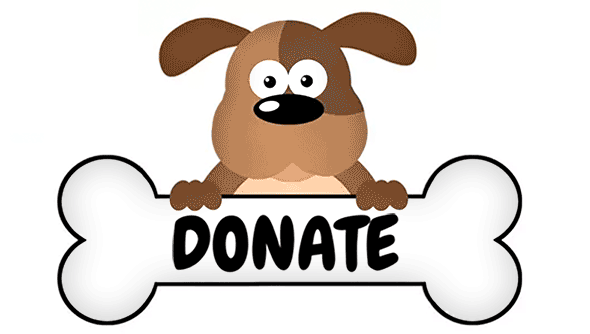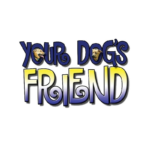10 Tips for Humans
1) Dogs “speak” through body language. Watch for these stress signals, so you know when to intervene:
- Tucking tail between legs
- Turning head away
- Backing away
- Trying to hide
- Licking lips
- Excessive yawning
- Excessive sniffing
- Unwillingness to take treats
- Whining or growling
- Half-moon eye (a white arc around the iris)
2) Mental stimulation is just as important as physical exercise. Thinking helps build confidence and provides enrichment.
- Use interactive toys that your dog can push, tug, drop, or roll to get treats out.
- Play games like “find it”, a treasure hunt created by you for your dog.
- Teach your dog tricks such as “shake”, “spin” or “crawl”.
- Take a positive training class! You will be amazed how quickly your dog will learn!
3) Being around young children can be stressful for dogs. Kids have high-pitched voices, move quickly, and are unpredictable. They chase, fall on, dress, hug, corner, and pick up dogs.
- Carefully monitor any interaction your dog has with children.
- Once a dog has had enough, even good dogs can bite! Help your dog get away to a safe place as soon as you see any signs of stress.
- Don’t let children crowd your dog – one at a time and only if your dog shows interest in them.
4) Management is your best friend. This is every dog trainer’s secret. Make your life easier by heading off problems and setting your dog up for success.
- Use baby gates and close doors to keep your dog out of areas where you don’t want him to be.
- Get the whole family involved in cleaning up; put away shoes and other items your dog may steal or chew.
- If you have more than one dog, feed them in separate areas.
- Keep a leash by your door, so when visitors arrive you can put a leash on your dog.
- Crate your dog or put him in a safe area if you know people are on their way to visit – especially important for timid, reactive or overly-excited dogs.
5) “Socialization” is not the same as exposure. Socialization is an over-used term that has come to mean “throw your dog into any and all situations and hope for the best”. Your #1 priority should be to help your dog feel safe.
- Your dog’s experiences with other dogs, people and environments need to be good ones.
- Dogs can develop anxieties from one bad incident.
- Don’t force your dog into situations that make him uncomfortable.
- Give your dog time to adjust. Introduce new people, dogs, places and things slowly and at your dog’s pace.
6) Training is a process. Dogs need time, patience, and consistency to learn our “rules”.
- Train your dog in a quiet environment first, then around mild distractions before expecting him to listen with that squirrel running by.
- Teach your dog what you want him to do, instead of correcting him for what you don’t want.
- You need to be more fun / interesting than the rest of the world – including that squirrel!
- Dogs do what works for them – what gets rewarded gets repeated.
7) The environments at dog parks and some of the larger daycare centers may be harmful for your dog. It’s up to you to keep your dog safe in any situation.
- Dogs that play non-stop are in a high state of arousal, making aggression more likely.
- Different breeds / dogs have different play styles – chasing, wrestling, body slamming, biting – that can cause tension between dogs.
- Dogs need to learn to be calm in the company of other dogs, but the opposite happens in these settings.
- At many daycare facilities there are too many dogs in one room, the employees are not all well-trained, and staff turnover is high.
- Humans at dog parks may be busy talking to one another and generally ignore or don’t understand their dogs’ behavior and signals.
- Being bitten, bullied, or even having a fight break out nearby can harm your dog’s well-being and behavior for years to come.
8) Human body language can be threatening to dogs. We approach dogs head-on, bend over them, and reach over their heads to pet them.
- Approaching a dog straight on (especially quickly) is a threat. Approach at an angle.
- Don’t lean over a dog. Bend at your knees, not at your waist.
- Pet dogs on their chest or under their chin, instead of reaching over to “pat” them on the head.
- If you don’t know a dog, wait until the dog comes to you (if they choose to!).
- NEVER punish your dog for growling! Your dog is telling you as clearly as he knows how that he is stressed. If you punish him for growling, your dog may go straight to biting without warning.
9) Most reactive/aggressive behavior is based on fear. Punishing fear just creates more fear. Punishing aggression just creates more aggression.
- Barking and lunging is how a dog makes something he is afraid of go away.
- Asking a dog to sit/stay as the scary thing goes by is like asking you to sit/stay when you are near a live snake.
- Dogs can learn to dislike other dogs, strangers, or children if that’s what they see at the same time they feel the pain or discomfort from a choke, prong or electronic collar.
- These collars can suppress a behavior through fear of punishment but do nothing to address the cause of a behavior. Punishment may seem to work in the short term, but many dogs either shut down or find another outlet for their anxiety.
10) You don’t need to intimidate or punish your dog to get the behavior you want. Your dog will respect you if you are consistent and kind.
- You don’t need to prove that “you’re the boss”. You are already the source of everything your dog wants – food, toys, activities, attention, access to the outside, etc.
- Punishment adds stress, and stress interferes with learning.
- Your dog may not know why he is being punished…and your behavior may seem unpredictable.
- Being positive with your dog builds trust. You and your dog will be a team.




